A Kualu to Remember
Throw a dart at a map of the world and it will likely land somewhere in the middle of an ocean. Throw it again. If it strikes land, chances are it will be someplace you’ve never heard of. Before I arrived in Malaysia, I’d heard of Kuala Lumpur, Penang and Borneo. Everywhere else was just a name on a map.
I left Singapore with the goal of traveling way up the east coast of Peninsular Malaysia, moving slowly, no more than a few hours at a time. The coast is not that long and I planned to cover the distance from Singapore to the Thai border in about ten leisurely days. My first stop was Pulau Tioman, then to the beach town of Cherating. Pulau Perhentian, a destination other travelers swore I could not miss, was still seven hours north. I threw a dart at a map and it landed in Kuala Terengganu.
Kuala Terengganu is the capital of Terengganu, one of the richest states in Malaysia. Once a fishing village, oil revenue has transformed the town into a bustling small city with 250,000 residents. There is nothing a visitor has to see, no significant architecture or historical sites. I arrived in the early afternoon and as I walked the city’s streets, along its broad beaches, through the colorful central market and finally in and out of narrow alleys in Chinatown, I was struck by its accessibility and the openness of the locals.

Entrance to Sultan's Palace, Kuala Terengganu
There are many reasons to travel. Some people seek out cultural attractions or natural wonders; some are fascinated by a region’s history, favoring trips to the past over living the present. A well-rounded journey takes in all these things. I’ve found since arriving in Asia, however, that I’m often led by something more primal: hunger. My stomach guides me. Or is it the taste buds?
The Lonely Planet entry for Kuala Terengganu says it’s a good place to sample some regional specialties. My goal for the 18 hours I would spend there was to try nasi gagang, a breakfast dish of rice and glutinous rice sweetened with coconut milk and wrapped around a morsel of fish. The whole thing is then enclosed in a banana leaf and served with a side of fish curry. In Japan I ate onigiri, triangles of rice in a seaweed wrapper. Nasi gagang sounded like the Malay version. But what would I do with so much time to kill before breakfast?
Anyone who is led by the stomach will eventually find his way to the central market, along with local buses a sure source of local color and flavor. A brisk walk along the waterfront and past the sultan’s palace brought me to the market, a split-level building divided into sections based on the goods for sale, from fruits and vegetables and fish on the street level to fabrics and housewares in the crowded aisles on the second floor.
I spent the next hour wandering the aisles, asking rudimentary questions about anything that caught my eye. Most of the vendors only spoke Malay, so there was a lot of pointing and shrugging of shoulders. I was offered samples: two varieties of salak (called snake fruit in English due to it’s hard scaly skin), a tart morsel of flesh around a hard brown pip; godol, a soft, subtly sweet chewy triangle the size of a caramel, made from glutinous rice and cane sugar; and keropok keping, fish crackers spiced with red chilies. The crackers are the dry version of keropok lekor, a mixture of fish paste and sago flour molded into long grey sausages.
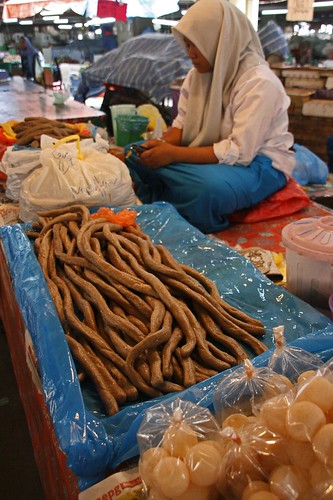
Keropok Lekor
Islam is the state religion of Malaysia and the residents of Kuala Terengganu reflected conservative views in the way they dressed. I changed into long pants before leaving my hotel just to feel more comfortable. Women, while active in all parts of society, wear headscarves (tudong, covering the head but not the face) and loose-fitting dresses that cover everything but the feet and hands –I’ve only seen two women wearing full veils in all my time in Malaysia. Now, after 10 days among modestly dressed women, I can understand the allure of a finely formed ankle.
I offer this aside for a reason. On the second floor of the market, I wandered through aisles of colorful silks, marveling at the variety and quality. In a few stalls, there were swaths of woven fabric, perhaps two feet by six feet, costing RM600, close to US$200, an astounding figure in a country where a meal can be had on the street for RM4. Rows of headscarves hung overhead and on the walls of the stalls in a dizzying array of colors and designs. My first few days in Malaysia I thought all the women looked like they wore the same things. With a little market research, I know notice the subtle differences in their dress. I don’t know enough about fashion, clothing, textiles or Islam to describe this further. I wish I could.
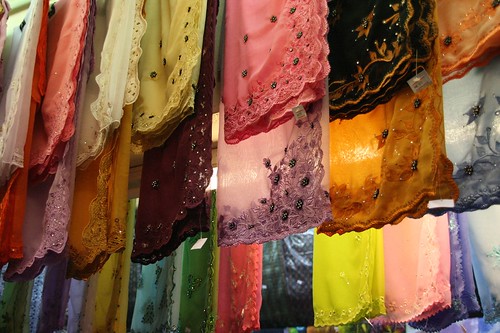
Headscarves
The afternoon was another scorcher, with high humidity. As I wandered through the streets of Kualu Terengganu’s small Chinatown, I only had one thing on my mind: liquid. I was thirsty. I noticed a group of people sitting on the patio at a restaurant called T. Homemade Café and wandered in for a look. A woman approached me and just said “what do you want to drink?” I guess it showed on my face.
Her approach was so direct and honest I decided there was no point in arguing. I ordered a watermelon juice and grabbed the nearest seat. T. Homemade Café is not just one restaurant. There are four or five stalls in a long dining room, another two or three set up outside. What is served depends on the time of day.
By my table on the patio and man was thinly slicing roast pork for plates of mee siam, a dish of thin noodles covered in a tamarind sauce and accompanied by meat and greens. I was hungry, the pork looked good, so I ordered some. It was an unremarkable meal, but I hadn’t eaten anything since the morning (other than a few handouts at the market) and it hit the spot. The watermelon juice was fresh and cold. In 15 minutes I was refreshed and thinking of moving on.
The same women who’d approached me earlier came back and said hello, asking if I wanted anything else. Out of the corner of my eye I noticed a signboard for the café that featured a glass of dragonfruit juice. I’d tried a white version of this tropical fruit in Australia and found it bland, somewhere between a watermelon and a kiwi, but without a bite. Dragonfruit also comes in a deep red variety, and I asked if this is what she served. She said yes, and I ordered a glass. What came to me was a frosty mug of purple juice, a mix of dragonfruit and lychee that was as close to a slurpee as I’d seen in months.
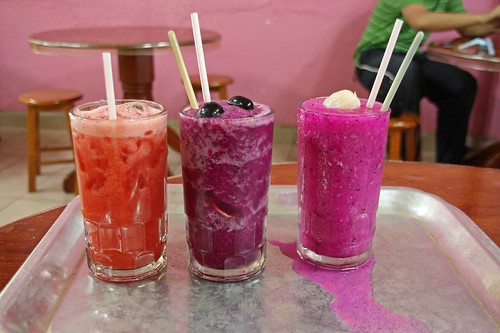
From left, Watermelon, Dragonfruit with Grape, Dragonfruit with Lychee
By this time I’d moved out of the heat and into the main dining room. It wasn’t much cooler, but the air was moved by a set of ceiling fans. The woman noticed as I pulled out my camera to take a picture of the juice. Then another women walked by with a tray carrying three more colorful mugs. The first woman told her to stop so I could take another photo. At this point I’d made a new friend.
The woman introduced herself as Jennifer. I’m not sure if she owned the restaurant; surely she was part of an extended family that worked there. She asked me the usual questions about my trip and then I asked where I could go for the best nasi gagang in town. She drew me a map to the real deal. She left me to my dragonfruit drink (delicious, by the way, much better than the white fruit I’d tried in Oz.
I was again about to leave when Jennifer came back. Somehow I got on to the subject of fruit and mentioned how I’d fallen in love with soursop in Singapore. “I have that too,” she said. “You want one?” With an offer of a mug of soursop juice on the table, I knew I wouldn’t be leaving anytime soon.
I finally made it out of there after three tall mugs of juice and a small plate of the Chinese version of keropok. After so much sweet juice, the fishy snack was a shock to my taste buds, especially when dipped in the spicy sambal on the side.
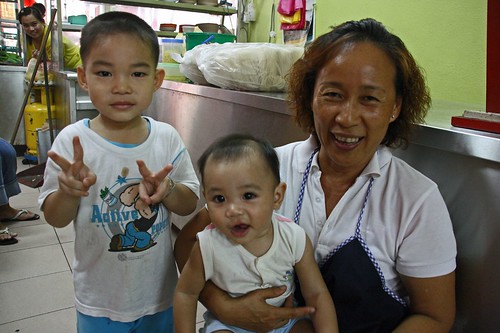
Jennifer and Kids
I said goodbye to Jennifer and her extended family, thinking I would never see them again. The plan was to wake up early, go for nasi gagang and catch a 10 am bus out of town. But I overslept and the 10 am bus broke down. I would have to wait until 11:30 to get out of town. Sometimes travelers don’t travel, they just sit and wait.
There was no question about my next move – I headed straight for T. Homemade Café. I was greeted by Jennifer, who immediately asked me if I’d like the nasi gagang. I confessed that I had overslept and she laughed, then told me she’d get me some.
“Where?” I asked.
“I will drive and pick it up,” she said.
“No, you can’t to do that.”
“Sit. What do you drink?”
I didn’t have a choice. Ten minutes later Jennifer returned with two banana leaf cones and a baggie filled with curry sauce. She fetch a small bowl for the curry and brought me a fork and spoon. Nasi gagang didn’t knock my socks off, but it is a very good breakfast food. It’s light, a bit sweet from the coconut milk and bracing from the curry. I suspect the fish at the center of the rise is last night’s leftovers.
When it came time to me to leave, for good this time, I asked Jennifer what I owed her for the food. She wouldn’t take one ringgit from me.
Kualu Terengganu didn’t exist for me before I threw that dart. Now it’s one of the highlights of my trip.
I left Singapore with the goal of traveling way up the east coast of Peninsular Malaysia, moving slowly, no more than a few hours at a time. The coast is not that long and I planned to cover the distance from Singapore to the Thai border in about ten leisurely days. My first stop was Pulau Tioman, then to the beach town of Cherating. Pulau Perhentian, a destination other travelers swore I could not miss, was still seven hours north. I threw a dart at a map and it landed in Kuala Terengganu.
Kuala Terengganu is the capital of Terengganu, one of the richest states in Malaysia. Once a fishing village, oil revenue has transformed the town into a bustling small city with 250,000 residents. There is nothing a visitor has to see, no significant architecture or historical sites. I arrived in the early afternoon and as I walked the city’s streets, along its broad beaches, through the colorful central market and finally in and out of narrow alleys in Chinatown, I was struck by its accessibility and the openness of the locals.

There are many reasons to travel. Some people seek out cultural attractions or natural wonders; some are fascinated by a region’s history, favoring trips to the past over living the present. A well-rounded journey takes in all these things. I’ve found since arriving in Asia, however, that I’m often led by something more primal: hunger. My stomach guides me. Or is it the taste buds?
The Lonely Planet entry for Kuala Terengganu says it’s a good place to sample some regional specialties. My goal for the 18 hours I would spend there was to try nasi gagang, a breakfast dish of rice and glutinous rice sweetened with coconut milk and wrapped around a morsel of fish. The whole thing is then enclosed in a banana leaf and served with a side of fish curry. In Japan I ate onigiri, triangles of rice in a seaweed wrapper. Nasi gagang sounded like the Malay version. But what would I do with so much time to kill before breakfast?
Anyone who is led by the stomach will eventually find his way to the central market, along with local buses a sure source of local color and flavor. A brisk walk along the waterfront and past the sultan’s palace brought me to the market, a split-level building divided into sections based on the goods for sale, from fruits and vegetables and fish on the street level to fabrics and housewares in the crowded aisles on the second floor.
I spent the next hour wandering the aisles, asking rudimentary questions about anything that caught my eye. Most of the vendors only spoke Malay, so there was a lot of pointing and shrugging of shoulders. I was offered samples: two varieties of salak (called snake fruit in English due to it’s hard scaly skin), a tart morsel of flesh around a hard brown pip; godol, a soft, subtly sweet chewy triangle the size of a caramel, made from glutinous rice and cane sugar; and keropok keping, fish crackers spiced with red chilies. The crackers are the dry version of keropok lekor, a mixture of fish paste and sago flour molded into long grey sausages.

Islam is the state religion of Malaysia and the residents of Kuala Terengganu reflected conservative views in the way they dressed. I changed into long pants before leaving my hotel just to feel more comfortable. Women, while active in all parts of society, wear headscarves (tudong, covering the head but not the face) and loose-fitting dresses that cover everything but the feet and hands –I’ve only seen two women wearing full veils in all my time in Malaysia. Now, after 10 days among modestly dressed women, I can understand the allure of a finely formed ankle.
I offer this aside for a reason. On the second floor of the market, I wandered through aisles of colorful silks, marveling at the variety and quality. In a few stalls, there were swaths of woven fabric, perhaps two feet by six feet, costing RM600, close to US$200, an astounding figure in a country where a meal can be had on the street for RM4. Rows of headscarves hung overhead and on the walls of the stalls in a dizzying array of colors and designs. My first few days in Malaysia I thought all the women looked like they wore the same things. With a little market research, I know notice the subtle differences in their dress. I don’t know enough about fashion, clothing, textiles or Islam to describe this further. I wish I could.

The afternoon was another scorcher, with high humidity. As I wandered through the streets of Kualu Terengganu’s small Chinatown, I only had one thing on my mind: liquid. I was thirsty. I noticed a group of people sitting on the patio at a restaurant called T. Homemade Café and wandered in for a look. A woman approached me and just said “what do you want to drink?” I guess it showed on my face.
Her approach was so direct and honest I decided there was no point in arguing. I ordered a watermelon juice and grabbed the nearest seat. T. Homemade Café is not just one restaurant. There are four or five stalls in a long dining room, another two or three set up outside. What is served depends on the time of day.
By my table on the patio and man was thinly slicing roast pork for plates of mee siam, a dish of thin noodles covered in a tamarind sauce and accompanied by meat and greens. I was hungry, the pork looked good, so I ordered some. It was an unremarkable meal, but I hadn’t eaten anything since the morning (other than a few handouts at the market) and it hit the spot. The watermelon juice was fresh and cold. In 15 minutes I was refreshed and thinking of moving on.
The same women who’d approached me earlier came back and said hello, asking if I wanted anything else. Out of the corner of my eye I noticed a signboard for the café that featured a glass of dragonfruit juice. I’d tried a white version of this tropical fruit in Australia and found it bland, somewhere between a watermelon and a kiwi, but without a bite. Dragonfruit also comes in a deep red variety, and I asked if this is what she served. She said yes, and I ordered a glass. What came to me was a frosty mug of purple juice, a mix of dragonfruit and lychee that was as close to a slurpee as I’d seen in months.

By this time I’d moved out of the heat and into the main dining room. It wasn’t much cooler, but the air was moved by a set of ceiling fans. The woman noticed as I pulled out my camera to take a picture of the juice. Then another women walked by with a tray carrying three more colorful mugs. The first woman told her to stop so I could take another photo. At this point I’d made a new friend.
The woman introduced herself as Jennifer. I’m not sure if she owned the restaurant; surely she was part of an extended family that worked there. She asked me the usual questions about my trip and then I asked where I could go for the best nasi gagang in town. She drew me a map to the real deal. She left me to my dragonfruit drink (delicious, by the way, much better than the white fruit I’d tried in Oz.
I was again about to leave when Jennifer came back. Somehow I got on to the subject of fruit and mentioned how I’d fallen in love with soursop in Singapore. “I have that too,” she said. “You want one?” With an offer of a mug of soursop juice on the table, I knew I wouldn’t be leaving anytime soon.
I finally made it out of there after three tall mugs of juice and a small plate of the Chinese version of keropok. After so much sweet juice, the fishy snack was a shock to my taste buds, especially when dipped in the spicy sambal on the side.

I said goodbye to Jennifer and her extended family, thinking I would never see them again. The plan was to wake up early, go for nasi gagang and catch a 10 am bus out of town. But I overslept and the 10 am bus broke down. I would have to wait until 11:30 to get out of town. Sometimes travelers don’t travel, they just sit and wait.
There was no question about my next move – I headed straight for T. Homemade Café. I was greeted by Jennifer, who immediately asked me if I’d like the nasi gagang. I confessed that I had overslept and she laughed, then told me she’d get me some.
“Where?” I asked.
“I will drive and pick it up,” she said.
“No, you can’t to do that.”
“Sit. What do you drink?”
I didn’t have a choice. Ten minutes later Jennifer returned with two banana leaf cones and a baggie filled with curry sauce. She fetch a small bowl for the curry and brought me a fork and spoon. Nasi gagang didn’t knock my socks off, but it is a very good breakfast food. It’s light, a bit sweet from the coconut milk and bracing from the curry. I suspect the fish at the center of the rise is last night’s leftovers.
When it came time to me to leave, for good this time, I asked Jennifer what I owed her for the food. She wouldn’t take one ringgit from me.
Kualu Terengganu didn’t exist for me before I threw that dart. Now it’s one of the highlights of my trip.

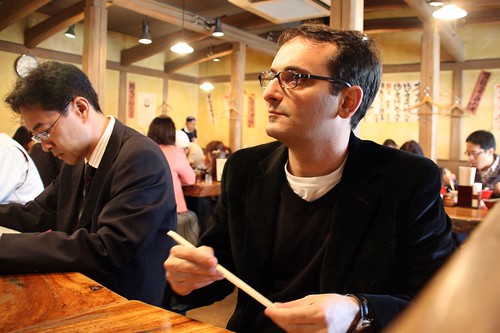

0 Comments:
Post a Comment
<< Home